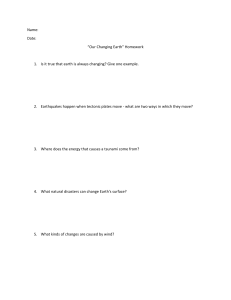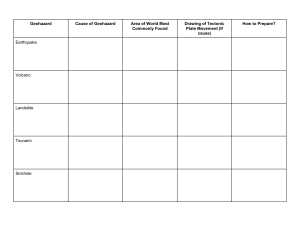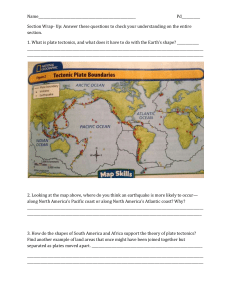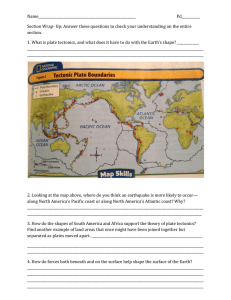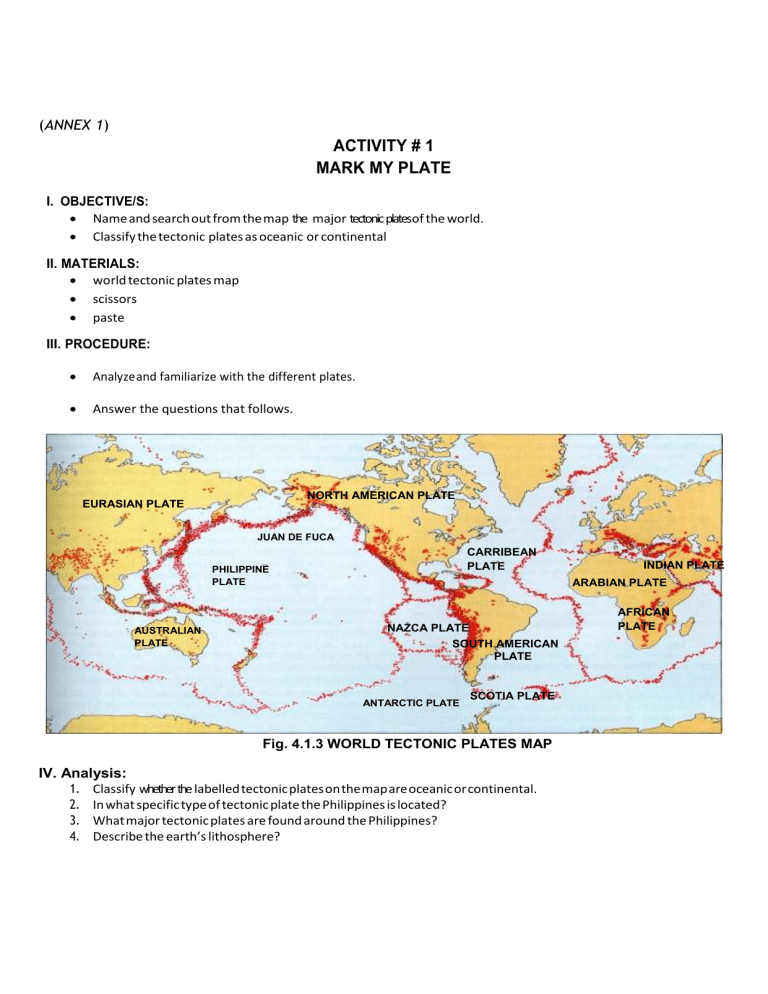
(ANNEX 1) ACTIVITY # 1 MARK MY PLATE I. OBJECTIVE/S: Name and search out from the map the major tectonic platesof the world. Classify the tectonic plates as oceanic or continental II. MATERIALS: world tectonic plates map scissors paste III. PROCEDURE: Analyze and familiarize with the different plates. Answer the questions that follows. NORTH AMERICAN PLATE EURASIAN PLATE JUAN DE FUCA PHILIPPINE PLATE CARRIBEAN PLATE ARABIAN PLATE COCOS PLATE AFRICAN PLATE NAZCA PLATE AUSTRALIAN PLATE PACIFIC PLATE INDIAN PLATE SOUTH AMERICAN PLATE ANTARCTIC PLATE SCOTIA PLATE Fig. 4.1.3 WORLD TECTONIC PLATES MAP IV. Analysis: 1. Classify whether the labelled tectonic plates on the map are oceanic or continental. 2. In what specific type of tectonic plate the Philippines is located? 3. What major tectonic plates are found around the Philippines? 4. Describe the earth’s lithosphere? (ANNEX 2) ACTIVITY # 2 LET’S MARK BOUNDARIES Objectives: Describe the distribution of active volcanoes, earthquake epicenters and major mountain belts. Determine the scientific basis for dividing the lithospheric plates. Materials Figure 5 Map of Earthquake distribution Figure 6 Map of Active Volcanoes of the world. Figure 7 Mountain ranges of the world transparent plastic sheet used for book cover, same size as a book page (2 sheets) marking pens (two different colors) Manila paper Procedures: 1. Trace the locations of the earthquake epicenters on a plastic sheet using a marking pen. 2. On another plastic sheet, trace the locations of volcanoes using the other marking pen. 3. Place the earthquake plastic sheet on top of the volcano plastic sheet. 4. Place the two plastic sheets on top of the map of mountain ranges. Analysis: Q1. How are earthquake distributed on the map? Q2. Where are they located? Q3.Where are there no earthquake? Q4. Why is it important for us to identify areas which are prone earthquakes? Q5. How are volcanoes distributed? Q6. Where are they located? Q7. Based on the map, mention a country that is unlikely to experience a volcanic eruption Q8. Compare the location of majority of earthquake epicenters with the location of volcanoes around the world. Q9. How will you relate the distribution of mountain ranges with the distribution of earthquakes epicenters and volcanoes? Q10. What do you think is the basis of scientists in dividing the Earth’s lithosphere into several plates? (ANNEX 3) ACTIVITY # 3 THE MOVES Objectives: Classify plate boundaries according to their movements; Compare the three types of boundaries. Materials: Manila paper, envelope , pictures, scotch tape or glue Procedure: 1. From the given pictures of plate boundaries examine the movement of each and classify where they belong as convergent, divergent, and transform. Convergent Divergent Transform Analysis: 1. Based on the movement as shown in the pictures, how did you classify the plates as convergent, divergent, and transform? 2. How would you describe the movements of the following? a. Convergent b. Divergent c. Transform 3. What are the similarities and differences of the different plate boundaries? Show your answers using a venn diagram below. CONVERGENT DIVERGENT TRANSFORM (ANNEX 4) ACTIVITY # 4 LET’S PUT BOUNDARIES BETWEEN US I. OBJECTIVE/S: Create models of the three types of plate boundaries Describe the interaction between the tectonic plates Compare the three types of plate boundaries II. MATERIALS: model printouts scissors scotch tape 1/16 illustration board III. PROCEDURES: Cut out the model printouts. Follow the instruction written on the printouts. (See attached printouts) ANALYSIS: 1. Put the models in a 1/16 illustration board. Determine the type of plate boundary represented by each replica. 2. Describe the interaction between the tectonic plates in each type of model. RUBRIC ACCURACY PRESENTATION ORGANIZATION AND MECHANICS LEGEND/KEY CONSTRUCTION 4 3 2 1 Shows a full Shows a good Shows a good Does not seem to understanding understanding understanding understand the of the topic. of the topic. of parts of the topic very well topic. Student was Student was Student was not able to describe able to describe Student was able to discuss any all details about details of able to describe details about his/her output his/her output few facts and his/h and recall a and recall details about er project and significant s his/her output was unable to amount of ome significant and recall any facts about the amount of the topic facts about the topic. topic. facts about the topic. Model is neat, Model is neat, Model is neat Model is messy accurate, easy accurate, and but contains or hard to follow. to follow, and easy to follow. some errors. shows creativity. All 1-2 parts of Legend, but No legend, forma legend are not most or tted correctly. formatted parts formatted correctly format incorrectly. ted incorrectly. The model is 95- The model is 85- The model is 100 94 % properly constructed butThe some modelimportant is % properly details are poorly constructed. missing and and carefully carefully constructed constructed Use this rubric to assess the product/output of each student. Name of Student: _____________________________ Total Score:_____________________ Teacher’s Signature:_________________ (ANNEX 5) ACTIVITY # 5 I. OBJECTIVE/S: Give specific examples of the three types of plate boundaries II. MATERIALS: articles/reading materials III. PROCEDURES: DICREPANT EVENTS Read the article/reading material carefully among and take note of the important events and facts. 1. GROUP I BOXING DAY TSUNAMI: THE FACTS ABOUT THE 2004 INDIAN OCEAN DISASTER It has been 10 years since the Indian Ocean tsunami and earthquake devastated parts of Indonesia, Sri Lanka, India and Thailand. The disaster was the world's deadliest tsunami, with over 230,000 people killed and half a million injured by the waves that battered the low-lying coast. The exact death toll is unknown. It was 7:58 a.m., December 26, 2004 when the tremendous quake struck beneath the Indian Ocean 160 miles west of Sumatra. Not only did it register at approximately a 9.3 magnitude (only the 1960 Chile earthquake measured higher at 9.5, though there may have been stronger tremors prior to the invention of seismographic equipment) and last nearly 10 minutes, the quake moved a full 750 miles of underwater fault line earth up to 40 feet. The movement of the earth–there is evidence that huge boulders weighing thousands of tons were pushed several miles along the ocean floor–caused a massive displacement of water. It is estimated that the resulting tsunami had an energy of 23,000 Hiroshima-type atomic bombs used during World War II. The violent movement of the Earth’s tectonic plates displaced an enormous amount of water, sending powerful shock waves in every direction. It was the result of the Indio-Australian Plate subducting below the Eurasian Plate. The tectonic plates in this area had been pushing against each other and building pressure for thousands of years. They continue to do so and will likely cause underwater earthquakes and tsunamis in the future. The rupture was more than 600 miles long, displacing the seafloor by 10 yards horizontally and several yards vertically. As a result, trillions of tons of rock moved, causing the largest magnitude earthquake in 40 years. 2. GROUP II THE GREAT 1906 SAN FRANCISCO EARTHQUAKE The worst natural disaster in U.S. history By: Chris Frantz At 5:12 a.m. on April 18, 1906, the people of San Francisco were awakened by an earthquake that would devastate the city. The main temblor, having a 7.7–7.9 magnitude, lasted about one minute and was the result of the rupturing of the northernmost 296 miles of the 800-mile San Andreas fault. But when calculating destruction, the earthquake took second place to the great fire that followed. The fire, lasting four days, most likely started with broken gas lines (and, in some cases, was helped along by people hoping to collect insurance for their property—they were covered for fire, but not earthquake, damage). With water mains broken, fighting the fires was almost impossible, and about 500 city blocks were destroyed. The damages were estimated at about $400,000,000 in 1906 dollars, which would translate to about $8.2 billion today. In 1906 San Francisco was the ninth largest U.S. city with a population of 400,000, and over 225,000 were left homeless by the disaster. The death toll is uncertain. City officials estimated the casualties at 700 but more modern calculations say about 3,000 lost their lives. The lowballing city figures may have been a public relations ploy to downplay the disaster with an eye on rebuilding the city. On April 20, the U.S.S. Chicago rescued 20,000 victims, one of the largest sea evacuations in history, rivalling Dunkirk in World War II. Martial law was not declared, but some 500 looters were shot by police and the military. The epicenter of this earthquake has moved around in the past 100 years, as advances in seismology have been made. It was first thought to have been in Marin County, then northwest of the Golden Gate, and most recently, in the Pacific Ocean about two miles west of San Francisco. The plate-tectonics theory that would shed some light on the quake wasn't formulated until the 1920s and not embraced until some three decades later. The San Andreas fault is on the boundary between the Pacific plate and the North American plate. During the earthquake, the ground west of the fault tended to move northward and, in the most extreme instance, a 21-foot shift was measured. Earthquake ruptures are fast movers—seismologists estimated the average speed of this rupture to have been 8,300 mi/hr going north, and 6,300 mi/hr traveling south. The quake was felt from southern Oregon to south of Los Angeles and inland as far as central Nevada. 3. GROUP III How the Marianas Trench Became Earth's Deepest Point By Richard A. Lovett, for National Geographic News James Cameron made headlines last month by successfully diving 6.8 miles (11 kilometers) to the deepest part of the Mariana Trench in a one-person submersible called the DEEPSEA CHALLENGER. Best known as a Hollywood director and now a National Geographic Society explorer-in-residence, Cameron is one of just three people to dive to Earth's deepest point, and the only one to be able to stay long enough to look around. The Mariana Trench isn't really the deep, narrow furrow that the word "trench" implies. Rather, the abyss marks the location of a subduction zone. It occurs where one part of the seabed—in this case the Pacific plate—dives beneath another, the Philippine plate. Though tectonic forces eventually warp the Pacific plate so that it makes a near-vertical dive into the Earth's interior, at seabed level the plate dips at a relatively gentle angle. A tectonic plate is a huge hunk of rock, 60 miles (97 kilometers) or thicker, said Robert Stern, a geophysicist at the University of Texas, Dallas. "In order for this to sink back into the earth, it has to bend downward, and these are very gentle bends." One reason the Mariana Trench is so deep, he added, is because the western Pacific is home to some of the oldest seafloor in the world—about 180 million years old. Seafloor is formed as lava at mid-ocean ridges. When it's fresh, lava is comparatively warm and buoyant, riding high on the underlying mantle. But as lava ages and spreads away from its source, it slowly cools and becomes increasingly dense, causing it to settle ever lower—as is the case with the Mariana Trench. 4. GROUP IV THE 2011 JAPAN TSUNAMI WAS CAUSED BY LARGEST FAULT SLIP EVER RECORDED Shifting plates and rising water The sudden movement of the Pacific tectonic plate under the North American plate caused a massive earthquake and a tsunami. The effects of the great earthquake were felt around the world, from Norway's fjords to Antarctica's ice sheet. Tsunami debris continues to wash up on North American beaches two years later. The Tohoku earthquake fault is a complex mosaic, with patches that stick and patches that slide smoothly. Though the entire fault ruptured, or broke apart, during the earthquake, some parts moved in different ways. The deeper part of the fault shifted quickly, while the shallow part, very near the surface, slid slowly. The Japan Trench is the result of the Pacific Ocean plate pressing down under the continental plate carrying the islands of Japan. The downward movement is called subduction. The effects of the great earthquake were felt around the world, from Norway's fjords to Antarctica's ice sheet. Tsunami debris continues to wash up on North American beaches two years later. In Japan, residents are still recovering from the disaster. Radioactive water was recently discovered leaking from the Fukushima Daiichi Nuclear Power Plant, which suffered a level 7 nuclear meltdown after the tsunami. Japan relies on nuclear power, and many of the country's nuclear reactors remain closed because of stricter seismic safety standards since the earthquake. Four years after the quake, about 230,000 people who lost their homes were still living in temporary housing, Japan's Reconstruction Agency said. In Japan, residents are still recovering from the disaster. Radioactive water was recently discovered leaking from the Fukushima Daiichi Nuclear Power Plant, which suffered a level 7 nuclear meltdown after the tsunami. Japan relies on nuclear power, and many of the country's nuclear reactors remain closed because of stricter seismic safety standards since the earthquake. Four years after the quake, about 230,000 people who lost their homes were still living in temporary housing, Japan's Reconstruction Agency said. The total damages from the earthquake and tsunami are estimated at $300 billion dollars (about 25 trillion yen), according to the Japanese government. The unexpected disaster was neither the largest nor the deadliest earthquake and tsunami to strike this century. That record goes to the 2004 Banda Aceh earthquake and tsunami in Sumatra, a magnitude-9.1, which killed more than 230,000 people. But Japan's one-two punch proved especially devastating for the earthquake-savvy country, because few scientists had predicted the country would experience such a large earthquake and tsunami. The tsunami caused a cooling system failure at the Fukushima Daiichi Nuclear Power Plant, which resulted in a level-7 nuclear meltdown and release of radioactive materials. The electrical power and backup generators were overwhelmed by the tsunami, and the plant lost its cooling capabilities. In July 2013, TEPCO, the Tokyo Electric Power Company, admitted that about 300 tons of radioactive water continues to leak from the plant every day into the Pacific Ocean. 5. WHAT IS HAPPENING AT SURIGAO DEL NORTE? At 10:03 PM on 10 February 2017, Friday, a strong earthquake of magnitude 6.7 shook the island of Mindanao. The epicenter is located 16 km offshore northwest of Surigao City, Surigao Strait at a depth of 10 km. The earthquake was generated by the movement of Surigao segment of the Philippine Fault. Small-magnitude earthquakes followed afterwards, and as of 4:00 PM of 11 February 2017, 101 aftershocks have been recorded by the PHIVOLCS seismic monitoring network. Why do earthquakes occur in Surigao del Norte? Eastern Mindanao, including Surigao del Norte, is one of the seismically active areas in the country because of the Philippine Fault and Philippine Trench, which are the main earthquake generators that can affect the area. In addition, there are other local faults which can be sources of small- to large-magnitude earthquakes. The Philippine Trench is the zone where the Philippine Sea Plate (PSP) subducts beneath the Philippine Mobile Belt (PMB) between offshore Bicol Peninsula and southeast Mindanao. Convergence between the PSP and the PMB occurs at the rate of 8 cms/year. Aside from strong ground shaking, what other seismic hazards are lifethreatening? Landslides, rock falls, and other types of mass movements may occur in mountainous or hilly areas. Liquefaction, manifested by sand boils or lateral spread may affect low-lying, water-logged, sandy areas at the banks of rivers. Tsunami is not expected from the kind of movement of the Philippine Fault - Surigao segment. The tsunami threat for Surigao del Norte would come from the movement of the Philippine Trench, located east of the province. What should be done by the affected communities? People are reminded to be cautious of structures visibly weakened or with signs of damage by the 10 February 2017, as these may be further damaged by aftershocks. In case of houses and other buildings with visible damage, it is best to contact the Municipal/City Engineering Office for advice. Engineers from the local government, other agencies and organizations should inspect buildings and other infrastructures to determine their integrity, and recommend appropriate actions to concerned affected groups or individuals. Slopes should be checked for tension cracks that may have resulted from the strong ground shaking. Tension cracks may make slopes more susceptible to landslides. These areas should be avoided. The best course of action is preparedness. In case of another felt earthquake, it is recommended that people protect themselves by doing the “duck, cover and hold”. In homes and offices, heavy furniture should be strapped to the walls, and appliances be secured to prevent them from toppling and causing injuries to persons. What is the role of PHIVOLCS? PHIVOLCS operates and maintains a network of 92 seismic stations spread across the Philippines. Data from the seismic stations are used to determine the location, magnitude and other characteristics of the earthquakes generated. IV. ANALYSIS: Illustrate how the involved tectonic plates move in a white cartolina. Label the plates involved and classify the plate boundary. Name the possible threats posed by the movement of tectonic plates based on the articles/reading materials and identify possible survival techniques After 15 minutes, each group will assign one representative to explain the event assigned to them. All visual aids will be posted on the board. Give each presenter 5-6 minutes to discuss their work. One article will be given to each group. Give the students 15 minutes to analyse the reading material and make a visual representation of the described event. In a white cartolina, show how the tectonic plates move using symbols like arrows, name the tectonic plates then identify the type of plate boundary involved. Make sure that the illustration is readable and properly labelled. Read the rubric for the activity so that the students will know how they will be graded. 1. It was the result of the Indio-Australian Plate subducting below the Eurasian Plate. (CONVERGENT BOUNDARY) 2. The San Andreas Fault is on the boundary between the Pacific plate and the North American plate. During the earthquake, the ground west of the fault tended to move northward and, in the most extreme instance, a 21-foot shift was measured. (STRIKE-SLIP BOUNDARY) http://academic.emporia.edu/aberjame/student/nester1/graphics/fig1_03.jpg 3. It occurs where one part of the seabed—in this case the Pacific plate— dives beneath another, the Philippine plate. (CONVERGENT BOUNDARY) https://media1.britannica.com/eb-media/82/160282-004-0B41D21B.jpg 4. The sudden movement of the Pacific tectonic plate under the North American plate caused a massive earthquake and a tsunami. (CONVERGENT BOUNDARY) http://www.earthobservatory.sg/files/project/images/Tohoku3-japan-oblique3.jpg 5. The Philippine Trench is the zone where the Philippine Sea Plate (PSP) subducts beneath the Philippine Mobile Belt (PMB) between offshore Bicol Peninsula and southeast Mindanao. Convergence between the PSP and the PMB occurs at the rate of 8 cms/year. (CONVERGENT BOUNDARY) THREATS POSED BY THE MOVEMENT OF TECTONIC PLATES Earthquakes Tsunami Loss of lives 4 CONTENT FOCUS 3 2 1 Information Information is Inadequate adequately supports mostly adequate and information is purpose of visual supportive of visual’s clearly supportive of purpose visual’s purpose Main appropriate to topic appropriate to topic stated 80-89% of the items 79-70% of the items items are labelled are and located correctly that can be labelled located read that and are labelled correctly located can be read that can be from at least 3 ft. away. away. away REQUIRED Includes all required All ELEMENTS elements as well as elements additional included information poster. a full Shows a a topic. topic. parts of the topic. SPEAKS CLEARLY Speak s 95%) the time, and mispronounces TIME-LIMIT and Speaks clearly all (100- distinctly 95%) the time, no mispronounces words. word. Presentation is 5-4 Presentation Several but 85%) of the were to of understand the topic very well. and Often mumbles time. understood or be OR no mispronounces more than one word. 3 Presentation to required most (94- cannot one Mispronounces is small good Does not seem GAINED (100- distinctly labelled view. missing. understanding all read and too the poster. good Shows and Speaks clearly are elements understanding of the distinctly and items are are included on the understanding of the clearly Less than 70% of the required 1 required elements on No main idea correctly and located correctly from at least 3 ft. Shows purpose is Main idea not clearly from at least 3 ft. KNOWLEDGE not support the visual’s Main idea is clearly LABELS-ACCURACY At least 90% of the idea Information does not more than one word. is 2 Presentation is less minutes long. minutes long. minutes long. than 2 minutes more minutes. GROUP NO. ___________________ TOTAL SCORE: _________________________ TEACHER’S SIGNATURE: ________________ than OR 5
